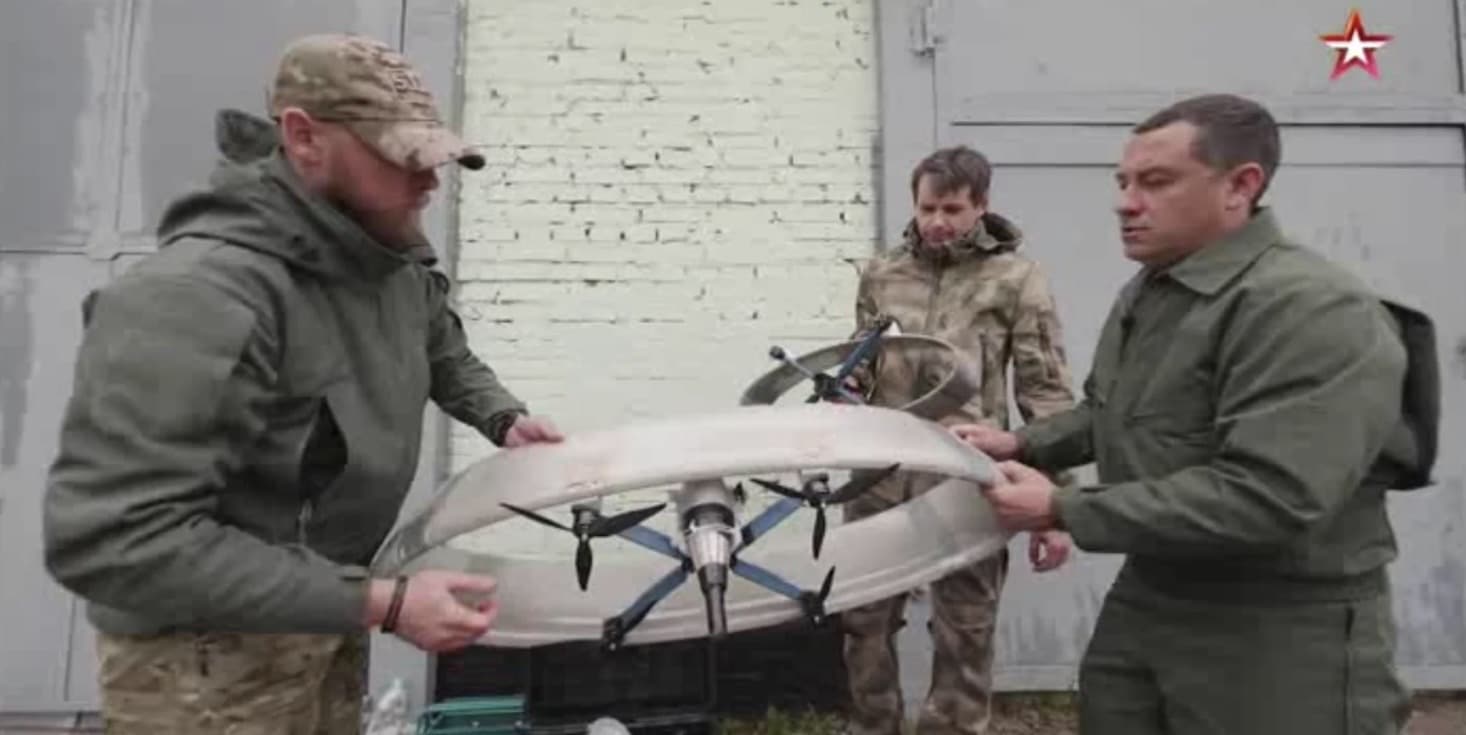Russia Deploys Ring-Wing “Kometa” Drones Over Ukraine As Experimental Design Triples Range

Ukrainian forces have spotted unusual Russian drones with circular ring-wing designs operating over front lines, marking the first combat deployment of an experimental aerodynamic configuration that could extend strike range by up to three times compared to conventional quadcopters. The Kometa drones, manufactured by Russian company Shag Vpered, represent Moscow’s latest attempt to gain tactical advantages through unconventional drone designs.
Ukrainian military expert Sergiy Beskrestnov, operating under the call sign “Flash,” first reported the sightings on his Telegram channel after Ukraine’s 14th separate unmanned systems regiment detected the aircraft operating in Ukrainian airspace. The distinctive ring-wing configuration—where the wingtips connect in a closed loop around a standard quadcopter frame—had previously appeared on Russian state television but marks its first confirmed use in combat operations.
What We Know About the Kometa Ring-Wing Drone
The Kometa series features a ring-shaped aerodynamic structure that encloses a standard first-person view (FPV) quadcopter frame. This annular or “closed wing” configuration eliminates traditional wingtips, theoretically reducing drag and extending operational range significantly beyond conventional designs.
According to information presented on the Russian military television program “Military Acceptance” that aired July 20, 2025, on the Zvezda channel, developer Stanislav Petin claimed “this scheme increases quadcopter flight range approximately three times.” During testing phases, the drone reportedly achieved flights approaching 40 kilometers (25 miles)—substantially beyond the typical 12-15 kilometer (7.5-9.3 mile) range of standard FPV drones used extensively by both sides.
Representatives from Ukraine’s 14th separate unmanned systems regiment initially struggled to identify the aircraft when first detecting it over the battlefield. The concept of ring-wing flight isn’t new to aviation—experimental designs date back over a century—but its application to small battlefield drones represents a novel tactical development.

Two Variants: Interceptor and Strike Versions
Russian manufacturer Shag Vpered, based in the Lipetsk Oblast, has developed two distinct variants of the Kometa platform according to the television program and subsequent analysis by Ukrainian military sources.
The smaller variant functions as an aerial interceptor designed specifically for counter-drone operations. This version is intended to engage Ukrainian reconnaissance and attack drones mid-flight, either by entangling them with nets or through direct kinetic impact. With Ukraine deploying approximately 9,000 drones daily and developing increasingly sophisticated interceptor capabilities, Russia appears to be developing its own drone-versus-drone response.
The larger Kometa variant takes a more aggressive approach, equipped with rocket-propelled grenade (RPG) munitions for striking ground targets or attacking Ukrainian drones at range. This model’s extended operational radius—reported at over 50 kilometers (31 miles)—would allow Russian forces to conduct deep strikes or intercept Ukrainian reconnaissance platforms well behind front lines.
Both variants retain the ability to rotate 90 degrees mid-flight, a capability that could prove valuable for surveillance missions or adjusting attack angles without requiring the entire aircraft to maneuver.
Ring-Wing Design Offers Extended Range
The ring-wing configuration represents a departure from the conventional quadcopter and fixed-wing designs that dominate modern drone warfare. By connecting the wingtips in a continuous loop, the design theoretically eliminates wingtip vortices—the spinning columns of air that form at conventional wing edges and create substantial drag.
However, Beskrestnov noted that the captured or observed units displayed “primitive control systems,” suggesting Russia may not have fully mastered the complex flight dynamics associated with ring-wing aircraft. Historical attempts at ring-wing designs, including France’s 1950s Coléoptère VTOL aircraft, proved dangerously unstable and were ultimately abandoned. The sophisticated flight control algorithms required to maintain stable flight with a ring-wing configuration present significant engineering challenges.
Ukrainian forces have captured or downed examples of the Kometa drone, allowing military analysts to examine its construction and capabilities. The extent of its deployment remains unclear, with no official Ukrainian military statements yet released regarding the system’s combat effectiveness or how many have been encountered.
Russian TV Program Revealed Drone Details
The July 20, 2025 broadcast on Zvezda television channel provided the first public glimpse of the Kometa program. The “Military Acceptance” series, produced by Russia’s Ministry of Defense media arm, frequently showcases new military technology as part of Moscow’s efforts to project technological prowess.
The program highlighted Shag Vpered’s development work and included claims about the drone’s enhanced range capabilities. The timing of the broadcast—just months before combat deployment—suggests Russia moved relatively quickly from development to battlefield testing, a pattern consistent with Moscow’s broader approach to drone warfare innovation.
This public revelation stands in contrast to many Russian military programs that remain tightly classified. The decision to broadcast details about the Kometa may indicate either confidence in the design or an attempt to generate deterrent effects through public disclosure of new capabilities.
Ukraine’s Growing Drone Defense Challenge
The appearance of ring-wing drones adds another layer of complexity to Ukraine’s already demanding air defense mission. Ukrainian forces currently face nightly bombardments of Iranian-designed Shahed attack drones, along with increasingly sophisticated Russian FPV platforms and long-range strike systems.
Ukraine has responded by developing cost-effective interceptor drones costing approximately $2,500 each that can hunt down $35,000 Shahed drones mid-flight. This economic approach to air defense has proven remarkably successful, with some Ukrainian units achieving hit rates as high as 80-90% against incoming threats.
The Kometa’s extended range could complicate these interception efforts by allowing Russian reconnaissance and strike platforms to operate from safer standoff distances. However, the drone’s reported control system limitations may offset some of these advantages. Ukrainian electronic warfare capabilities have proven highly effective at disrupting less sophisticated Russian drone platforms, and the Kometa’s success will likely depend on how well its control systems can resist jamming.
Russia has also established elite drone warfare units like Rubicon, which employ advanced tactics including thermal-equipped FPV drones and sophisticated electronic warfare to hunt Ukrainian pilots. The integration of ring-wing platforms into these specialized units could represent a more significant threat than their deployment with conventional forces.
DroneXL’s Take
The Kometa ring-wing drone reveals something fascinating about Russia’s approach to the drone warfare technology race—and it’s a stark contrast to how Ukraine is solving the same problems.
Here’s the technical reality: ring-wing designs offer genuine aerodynamic advantages. By eliminating wingtips entirely, they reduce induced drag by approximately 50% compared to conventional wings with the same span. Research shows these closed-loop configurations can increase range by 30-35% while boosting payload capacity by similar margins. Wind tunnel studies consistently demonstrate “efficiency factors well above 1” for annular wing designs. The physics work.
But here’s where it gets interesting: achieving those theoretical benefits requires extraordinarily sophisticated flight control systems. The upper and lower sections of a ring wing can stall at different rates, creating unpredictable pitch behavior. France’s 1950s Coléoptère ring-wing VTOL program failed spectacularly because the aircraft proved dangerously unstable despite years of development. Modern control algorithms can solve these challenges, but it requires exactly the kind of advanced software development that Russia has consistently struggled with throughout this conflict.
Ukraine extended FPV drone range through a completely different path—AI-assisted targeting modules costing $70 that improve hit rates from 20% to 80%, sophisticated electronic warfare resistance, and innovative battery management. They’re solving range and efficiency problems through software and tactics, not exotic airframes. We’ve been covering Ukraine’s hardware constraints limiting full drone autonomy, but they’ve compensated brilliantly through human-in-the-loop systems enhanced by smart software.
Russia is taking the opposite approach: solve efficiency problems through brute-force aerodynamics rather than mastering the complex flight control and AI systems Ukraine has developed. Ukrainian expert Beskrestnov’s observation about “primitive control systems” is damning—it suggests Russia built the sexy airframe but hasn’t cracked the hard software problem of actually flying it well.
This mirrors Russia’s broader technology strategy throughout the war. They can manufacture hardware—we’ve seen that with their massive Alabuga drone factory producing 5,500+ Shahed clones monthly. But when it comes to sophisticated software, electronic warfare resistance, and autonomous systems, they’re consistently playing catch-up to Ukrainian innovation.
The ring-wing Kometa might achieve its claimed 40-50 kilometer range through pure aerodynamic efficiency, but if the control systems are indeed primitive, Ukrainian electronic warfare will exploit that weakness relentlessly. We’ve watched this pattern repeat: Russia introduces hardware innovation, Ukraine counters with software and tactics that neutralize the advantage.
The broader lesson for drone professionals? Hardware alone doesn’t win the modern drone warfare technology race. Ukraine’s success with relatively conventional airframes enhanced by brilliant software proves that elegant code beats exotic engineering when you’re iterating in real combat conditions. Russia’s ring-wing experiment will either prove that sophisticated flight control can unlock real advantages—or it’ll join the graveyard of technically impressive but operationally impractical designs that couldn’t survive contact with Ukrainian EW and tactics.
What do you think? Share your thoughts in the comments below.
Discover more from DroneXL.co
Subscribe to get the latest posts sent to your email.
Check out our Classic Line of T-Shirts, Polos, Hoodies and more in our new store today!

MAKE YOUR VOICE HEARD
Proposed legislation threatens your ability to use drones for fun, work, and safety. The Drone Advocacy Alliance is fighting to ensure your voice is heard in these critical policy discussions.Join us and tell your elected officials to protect your right to fly.
Get your Part 107 Certificate
Pass the Part 107 test and take to the skies with the Pilot Institute. We have helped thousands of people become airplane and commercial drone pilots. Our courses are designed by industry experts to help you pass FAA tests and achieve your dreams.

Copyright © DroneXL.co 2025. All rights reserved. The content, images, and intellectual property on this website are protected by copyright law. Reproduction or distribution of any material without prior written permission from DroneXL.co is strictly prohibited. For permissions and inquiries, please contact us first. DroneXL.co is a proud partner of the Drone Advocacy Alliance. Be sure to check out DroneXL's sister site, EVXL.co, for all the latest news on electric vehicles.
FTC: DroneXL.co is an Amazon Associate and uses affiliate links that can generate income from qualifying purchases. We do not sell, share, rent out, or spam your email.


















